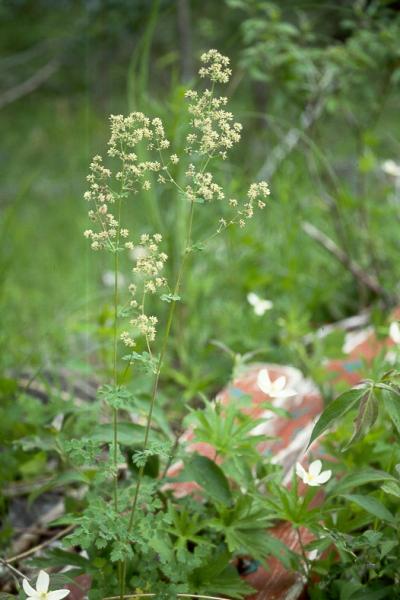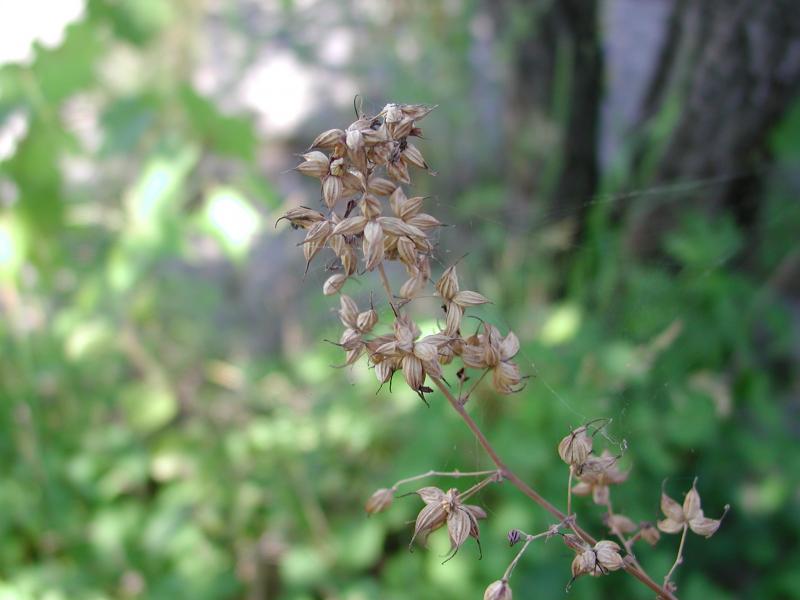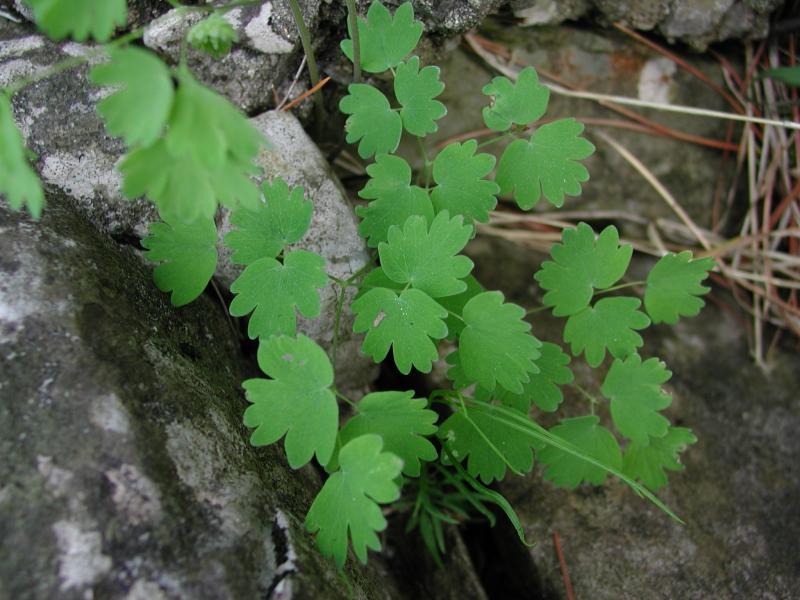Veiny Meadow-rue
Thalictrum venulosum var. confine (Fern.) Boivin
- Class
- Dicotyledoneae (Dicots)
- Family
- Ranunculaceae (Buttercup Family)
- State Protection
- Endangered
Listed as Endangered by New York State: in imminent danger of extirpation in New York. For animals, taking, importation, transportation, or possession is prohibited, except under license or permit. For plants, removal or damage without the consent of the landowner is prohibited.
- Federal Protection
- Not Listed
- State Conservation Status Rank
- S1
Critically Imperiled in New York - Especially vulnerable to disappearing from New York due to extreme rarity or other factors; typically 5 or fewer populations or locations in New York, very few individuals, very restricted range, very few remaining acres (or miles of stream), and/or very steep declines.
- Global Conservation Status Rank
- G4?
Apparently Secure globally (most likely) - Conservation status is uncertain, but most likely uncommon in the world but not rare; usually widespread, but may be rare in some parts of its range; possibly some cause for long-term concern due to declines or other factors. More information is needed to assign a firm conservation status.
Summary
Did you know?
Veiny Meadow-rue's flowers have no petals. The distinctive "starburst" pattern of its flowers are made by elongated stamens (Gleason and Cronquist 1991).
State Ranking Justification
There are only 5 existing occurrences and 2 historical occurrences (both from Clinton County) in the state. Only two of the verified occurrences are ranked as "good" and have populations of more than 50 plants, and the undisturbed shoreline habitat it favors has been impacted in many areas.
Short-term Trends
Only two of the the five verified populations have had population trends documented; these populations appear to be stable or increasing.
Long-term Trends
One of the verified populations has persisted at the site since at least 1965; additional data on long-term trends are lacking.
Conservation and Management
Threats
Invasive species, including purple loosestrife (Lythrum salicaria) threaten some populations. Boat launches and other human activities may also threaten the plants and their Lake Champlain shoreline habitats.
Conservation Strategies and Management Practices
These shoreline sites need to be protected from human activity, including at boat launches.
Habitat
Habitat
In New York, Veiny Meadow-rue has been found growing at cobbly shorelines, wet meadows, and calcareous rock outcrops along or near the Lake Champlain shoreline (New York Natural Heritage Program 2008). Rocky or gravelly soil, often along shores (Gleason and Cronquist 1991). Alluvial or rocky river shores, talus (Haines and Vining 1998).
Associated Ecological Communities
- Calcareous shoreline outcrop
(guide)
A community that occurs along the shores of lakes and streams on outcrops of calcareous rocks such as limestone and dolomite. The vegetation is sparse; most plants are rooted in rock crevices.
- Cobble shore wet meadow
(guide)
A community that occurs on the cobble shores of lakes and streams where the substrate is moist from seepage or intermittent flooding. These communities are likely to be scoured by floods or winter ice floes, but there is apparently no significant accumulation of pack ice.
Associated Species
- Amphicarpaea bracteata (hog peanut)
- Andropogon gerardii
- Apocynum sp.
- Asclepias syriaca (common milkweed)
- Calystegia sepium (hedge bindweed)
- Campanula rotundifolia (hare-bell)
- Desmodium sp.
- Eleocharis obtusa
- Eleocharis palustris (common spike-rush)
- Eurybia macrophylla (large-leaved-aster)
- Euthamia graminifolia (common flat-topped-goldenrod)
- Eutrochium maculatum
- Festuca sp.
- Leontodon autumnalis
- Lobelia kalmii (Kalm's lobelia)
- Lycopus americanus (American bugleweed, American water-horehound)
- Lysimachia ciliata (fringed-loosestrife)
- Lythrum salicaria (purple loosestrife)
- Melilotus albus (white sweet-clover)
- Mentha arvensis (field mint)
- Muhlenbergia glomerata (spike muhly)
- Oenothera biennis (common evening-primrose)
- Physostegia virginiana
- Poa compressa (flat-stemmed blue grass, Canada blue grass)
- Potentilla anserina
- Rhamnus cathartica (European buckthorn)
- Rubus hispidus (swamp dewberry)
- Schoenoplectus americanus (chair-maker's bulrush)
- Sisyrinchium mucronatum (sharp-tipped blue-eyed-grass)
- Solanum dulcamara (bitter-sweet nightshade)
- Solidago nemoralis
- Spartina pectinata (prairie cord grass)
- Stachys tenuifolia
- Thelypteris palustris
- Trifolium repens (white clover)
- Ulmus americana (American elm)
- Vicia cracca (tufted vetch)
- Viola sp.
- Vitis riparia (river grape, frost grape)
Range
New York State Distribution
In New York this species is known only from the Lake Champlain valley and shores in Essex and Clinton Counties.
Global Distribution
Veiny Meadow-rue is found throughout most of Canada, and in the northern U.S. states from the Pacific Northwest, south along the Rocky Mountains, and east along the northern tier of states to New York, Vermont, and Maine.
Identification Comments
General Description
Veiny Meadow-rue is a perennial herbaceous species which grows from rhizomes, up to 1 m tall. The leaves are alternate, and twice-divided, and the lobes of the leaflets are deeply cut, with distinct veins, and are at least sparsely glandular on the underside. The lower leaves have petioles, but the one directly below the infloresence is sessile or has only a short (less than 3 cm) petiole. The sepals are inconspicuous, the yellowish-greenish or pinkish flowers instead dominated by the many elongated stamens. The fruit are inward-curving achenes.
Best Life Stage for Proper Identification
Veiny Meadow-rue is best identified when in flower or fruit.
Similar Species
Thalictrum dioicum is similar to Thalictrum venulosum var. confine, but differs by flowering in May (Thalictrum venosum var. confine flowers in June or July), by having its infloresence subtended by a long-petioled leaf, and by its straight achenes.
Best Time to See
Veiny Meadow-rue flowers in June and July, and the fruits may persist through September.
- Vegetative
- Flowering
- Fruiting
The time of year you would expect to find Veiny Meadow-rue vegetative, flowering, and fruiting in New York.
Veiny Meadow-rue Images
Taxonomy
Veiny Meadow-rue
Thalictrum venulosum var. confine (Fern.) Boivin
- Kingdom Plantae
- Phylum Anthophyta
- Class Dicotyledoneae
(Dicots)
- Order Ranunculales
- Family Ranunculaceae (Buttercup Family)
- Order Ranunculales
- Class Dicotyledoneae
(Dicots)
- Phylum Anthophyta
Additional Common Names
- Late Meadow-rue
Synonyms
- Thalictrum confine Fern.
Comments on the Classification
Flora of North America recognizes Thalictrum venulosum and T. confine as separate species. These two species, along with T. occidentale, are very similar and the NY Flora Atlas treats them as varieties. More research may support recognition as a full species or lumping of all related taxa under T. venulosum.
Additional Resources
References
Edinger, Gregory J., D.J. Evans, Shane Gebauer, Timothy G. Howard, David M. Hunt, and Adele M. Olivero (editors). 2002. Ecological Communities of New York State. Second Edition. A revised and expanded edition of Carol Reschke's Ecological Communities of New York State. (Draft for review). New York Natural Heritage Program, New York State Department of Environmental Conservation. Albany, NY. 136 pp.
Fernald, M.L. 1950. Gray's manual of botany. 8th edition. D. Van Nostrand, New York. 1632 pp.
Gleason, Henry A. and A. Cronquist. 1991. Manual of Vascular Plants of Northeastern United States and Adjacent Canada. The New York Botanical Garden, Bronx, New York. 910 pp.
Haines, A. and T.F. Vining. 1998. Flora of Maine, A Manual for Identification of Native and Naturalized Vascular Plants of Maine. V.F.Thomas Co., Bar Harbor, Maine.
Holmgren, Noel. 1998. The Illustrated Companion to Gleason and Cronquist's Manual. Illustrations of the Vascular Plants of Northeastern United States and Adjacent Canada. The New York Botanical Garden, Bronx, New York.
Kartesz, J.T. 1994. A synonymized checklist of the vascular flora of the United States, Canada, and Greenland. 2nd edition. 2 vols. Timber Press, Portland, OR.
New York Natural Heritage Program. 2010. Biotics database. New York Natural Heritage Program. New York State Department of Environmental Conservation. Albany, NY.
New York Natural Heritage Program. 2024. New York Natural Heritage Program Databases. Albany, NY.
Voss, E.G. 1985. Michigan Flora. Part II. Dicots (Saururaceae - Cornaceae). Cranbrook Institute of Science and University of Michigan Herbarium. Ann Arbor, Michigan. 724 pp.
Weldy, T. and D. Werier. 2010. New York flora atlas. [S.M. Landry, K.N. Campbell, and L.D. Mabe (original application development), Florida Center for Community Design and Research http://www.fccdr.usf.edu/. University of South Florida http://www.usf.edu/]. New York Flora Association http://newyork.plantatlas.usf.edu/, Albany, New York
Weldy, Troy W. and David Werier. 2005. New York Flora Atlas. [S.M. Landry, K.N. Campbell, and L.D. Mabe (original application development), Florida Center for Community Design and Research. University of South Florida]. New York Flora Association, Albany, NY. Available on the web at (http://newyork.plantatlas.usf.edu/).
Links
About This Guide
Information for this guide was last updated on: May 22, 2008
Please cite this page as:
New York Natural Heritage Program. 2024.
Online Conservation Guide for
Thalictrum venulosum var. confine.
Available from: https://guides.nynhp.org/veiny-meadow-rue/.
Accessed July 26, 2024.


